I didn’t see Peter Relton’s production of Tosca for Grange Park Opera when it inaugurated the company’s new Theatre in the Woods at West Horsley in 2017, so it was good to have an opportunity to enjoy Francis O’Connor’s appealing and imposing three-dimensional sets – tweaked a little here, and atmospherically lit by Tim Mitchell – which have returned to the house for this new production by Stephen Medcalf.
Relton had updated the acction to Mussolini’s Rome; Medcalf adds a Nazi presence, making, I presume, Cavaradossi and Angelotti members of the Italian resistance. This rather smooths over the complex and bumpy alliance between Italian and German fascism, both before and during WW2, when any sense of ‘union’ between the states was more a marriage of convenience than a firm alliance of sister states. In any case, here, Scarpia communicates solely with his Italian henchmen and ignores the swastika-bearing Germans, so that their presence seems like a gimmick rather than anything dramatically meaningful.
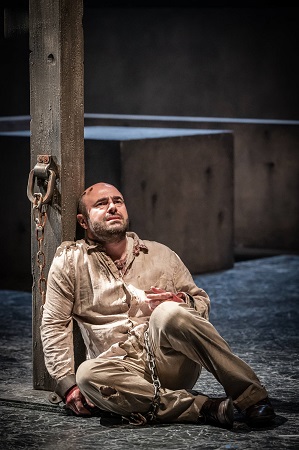
Some things don’t convince. A sense of outside and inside is deftly created by the presence of a tramp sleeping alongside the walls of the bomb-damaged Sant’Andrea della Valle. He is subsequently woken and ushered inside by a white-wimpled nun, presumably trying to save his soul, but this distracts from the main action. And, the nun reappears on the Castel Sant’Angelo roof, inexplicably singing the song normally sung by a passing shepherd boy (Katie Macdonald is listed as ‘Shepherd Boy’ in the credits). Whatever Medcalf was intending to communicate here remains elusive. Scarpia and Tosca’s tussle at the end of Act 1 takes place alongside the congregation gathering for the Te Deum, but the latter are either so rapt in their devotion that they don’t notice or they judiciously avert their eyes.
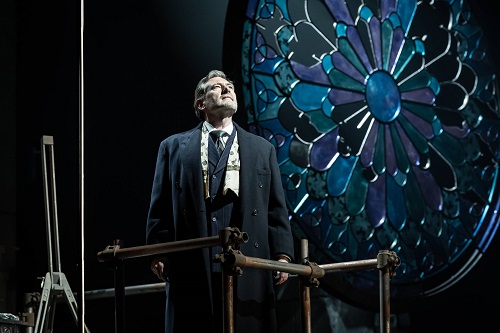
There are some neat touches, though. In Act 2, in the Palazzo Farnese one chandelier has collapsed to the floor – an effective symbol of the intrinsic and encroaching rot of the regime – and the French windows are protected with tape, a precaution evidently necessary judging from the sounds of battle from afar. But the shattered stained-glass mosaic from the S. Andrea reappears: is Scarpia trying to save his soul? And, why does he keep grasping his own arm?
There are a few over-the-top gestures too. A toqued chef blow-torches Scarpia’s supper while Cavaradossi is being interrogated, and then, when Cavaradossi is taken to prison cell, the same chef reappears to play jailor and torturer – doesn’t Scarpia have enough police fit for the job? Or, is this an allusion to Ralph Fiennes’ sadistic chef in The Menu?
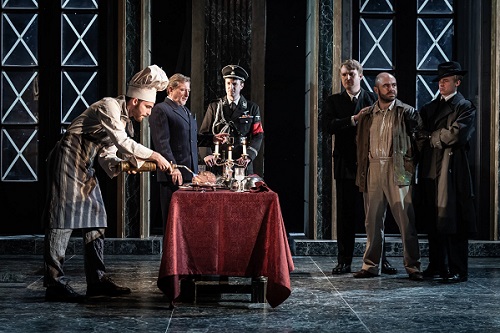
During ‘Vissi d’arte’, Scarpia paws at Tosca, denying her a moment of interiority as she asks why God has abandoned her in her hour of need. And, given the feminist feistiness of this Tosca, surely she would shove him fiercely away? He also paws at, or rather pulverises, a hunk of rare beef with a meat carver, not quite in synch with the score. It’s not this knife, though, but a carving fork which proves his undoing, though Tosca also feels the need to strangle him with his tie for good measure. About to depart, bearing, she thinks, her guarantee of safe passage, she returns and places candles by the side of the corpse, then takes off her crucifix and lays it upon the dead body. It’s not clear if she is trying to ensure his safe passage to the next world or her own.
We’re denied the battlement-denouement, too. O’Connor’s execution setting is a brutal modernist concrete rooftop. The only leap that Tosca makes is onto the bayonet at the end of the rifle of one of the firing squad who have executed Cavaradossi.
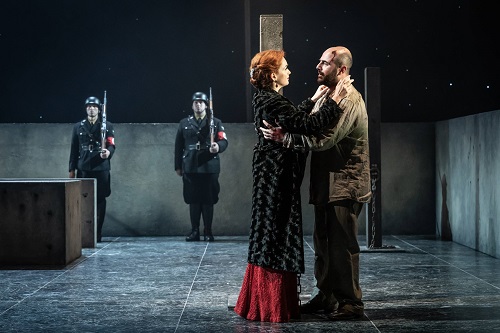
On opening night, the singing was often compelling but a little inconsistent. The Polish soprano Izabela Matula has a big, penetrating voice which she uses in a ‘big’ way, but which has only one real colour and mode – one brilliant for the histrionic diva moments and for combatting Scarpia’s demands in Act 2 – Matula was thrilling in the moments of emotional extremity – but lacking in a complementary tenderness and contemplativeness. She was terrifically combative, in conflicts with both her lover and his nemesis, but neither persuasively pious nor flirtatiousness in Act 1.
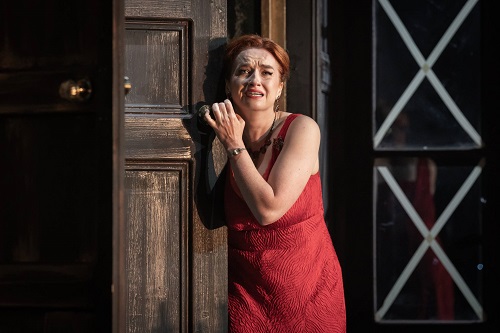
The Georgian tenor Otar Jorjikia sang the role of Cavaradossi with muscular fervour, but his voice was a little unyielding. The upper reaches weren’t strained but neither were they relaxed. He didn’t quite reach the peak in ‘Recondita armonia’, which was otherwise appealingly sung, and often didn’t seem inclined to hang around at the top, resulting in some lack of synchronisation with the pit. But, Jorjikia gave it his all in his cries of victory, which rang true and clear, and held his own well enough in the final Act 3 duet, even if ‘E lucevan le stelle’ felt a bit over-tired. Certainly, dramatically he created a powerful and tense sense of antagonism and defiance in the face of Scarpia’s cruelty and corruption.
The best of the main trio was the Canadian baritone Brett Polegato, making his role debut. He sang with authority, and with a strange and disturbing blend of menace and urbanity, aloof from, or contemptuous of, even his closest associates – Robin Horgan’s well-sung Spoletta was evidently daunted by his vicious master. This Scarpia was vocally intimidating but never unattractive, a sort of matinee idol turned bad.
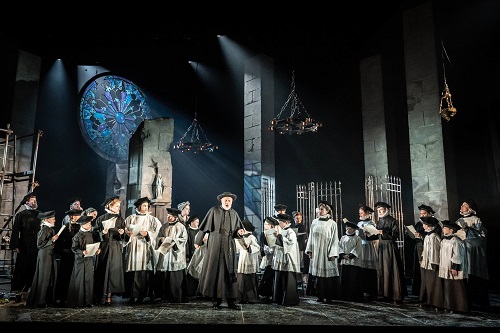
Alan Ewing’s Angelotti was focused of voice and characterisation, and the Sacristan, persuasively sung by Alan Slater, wasn’t, for once, played for laughs – though the children teased him, he was convincingly devout. The said children, and the GPO chorus were in fine voice. There was a notable cameo, too, from the uncredited Jailor (I think this was Henry Grant Kerswell) in Act 3, who nonchalantly smoked a cigarette, indifferent to Tosca’s pleading, and contemptuously tore up her false letter of safe passage.
The BBC Concert Orchestra under Mark Shanahan were secure, and often found attractive colours, but the big moments were controlled rather than climactic.
Medcalf tells the tale fluently and engagingly, and there’s much visually and vocally to enjoy. But, excepting the eponymous heroine, the production needs a bit more fire in its belly.
Claire Seymour
Floria, Tosca – Izabela Matula, Mario Cavaradossi – Otar Jorjikia, Baron Scarpia – Brett Polegato, Angelotti – Alan Ewing, Sacristan – Andrew Slater, Spoletta – Robin Horgan, Sciarrone – Thomas Isherwood, Shepherd Boy – Katie Macdonald; Director – Stephen Medcalf, Conductor – Mark Shanahan, Designer – Francis O’Connor, Lighting Designer – Tim Mitchell, BBC Concert Orchestra, Grange Park Opera Chorus.
Theatre in the Woods, Grange Park Opera, West Horsley; Saturday 10th June 2023.
ABOVE: Tosca (c) Marc Brenner